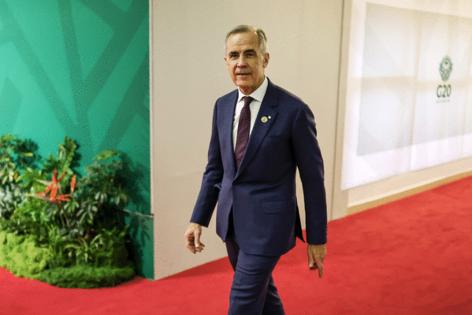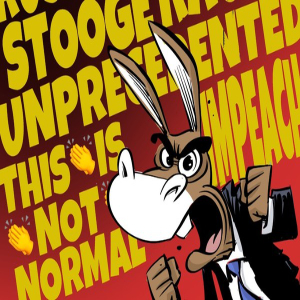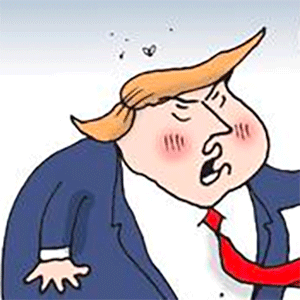US-Canada trade talks frozen as Carney weighs DC trip next week
Published in News & Features
OTTAWA, Canada — Trade talks between the United States and Canada remain stalled, and there’s an emerging belief in both governments that key issues will be rolled into next year’s broader review of the North American trade accord, people familiar with the matter said.
There have been no negotiations since U.S. President Donald Trump’s Oct. 23 social media post that halted them, the people said, speaking on condition of they not be identified. Until that day, the two sides had been discussing a limited agreement that may have eased some U.S. tariffs on steel and aluminum, which stand at 50% for Canada and most other American trading partners.
Trump was angered by an advertising campaign sponsored by the government of Ontario that used parts of a 1987 speech by Ronald Reagan to make the case against tariffs. The president said on Oct. 25 that he would impose an additional 10% tariff on Canada as punishment for the ad. But there’s no plan to proceed with that in the immediate term, according to a U.S. official. It’s not clear when, or if, Trump will impose the additional levy.
Trump and Prime Minister Mark Carney may cross paths again next week. Initial planning work is underway for the Canadian leader to travel to Washington on Dec. 5 to attend the draw for the 2026 World Cup, according to people with knowledge of the event. The tournament is being co-hosted by the U.S., Canada and Mexico.
If Carney does attend, it would put the two leaders in the same room for the first time since the Asia-Pacific Economic Co-operation summit in South Korea in late October, when Carney apologized for the Ontario TV ad. But Carney may simply go just to attend the event itself, with no additional meetings on trade taking place, said one person familiar with the matter.
Spokespeople for Carney and Trump declined to comment on whether the prime minister will attend the draw, which is taking place at the John F. Kennedy Center for the Performing Arts. The White House and office of the U.S. Trade Representative did not respond to requests for comment on the status of trade talks.
With U.S. talks on ice, Carney has sought to strike trade and investment deals with other countries, with a long-term goal of doubling Canada’s non-U.S. exports. The United Arab Emirates committed to invest C$70 billion ($50 billion) in Canada after Carney visited the country last week. Canada and India have also restarted long-dormant trade talks.
During a news conference on the sidelines of the Group of 20 Summit in Johannesburg on Sunday, Carney showed some irritation when pushed by a reporter on when he last spoke with Trump. “Who cares? It’s a detail. I spoke to him. I’ll speak to him again when it matters,” he replied.
“I look forward to speaking to the president soon, but I don’t have a burning issue to speak with the president about right now. When America wants to come back and have the discussions on the trade side, we will have those discussions.”
A year after Trump touched off a political crisis in Canada with a threat of a 25% tariff, Canadian negotiators have to accept that appealing to history and alliances doesn’t tend to work with this president, said Eric Miller, head of Washington-based consultancy Rideau Potomac Strategy Group and a former Canadian government official.
In Trump’s view, “you’re a counterparty and this is a commercial negotiation,” he said. But the Canadian side has little choice but to try to reach some kind of trade truce with the U.S. “You can’t get emotional. You can’t give up.”
Carney’s economic strategy is built, in part, around trade diversification, but that’s more difficult for Canada than for almost any other country in the world. About three-quarters of its goods exports were shipped to U.S. buyers last year, led by crude oil and energy products.
U.S. tariffs have curbed some of that business, but not destroyed it, thanks to a tariff exemption that applies to a broad array of products, provided they comply with the rules of the U.S.-Mexico-Canada Agreement.
U.S. goods imports from Canada were $260 billion in the first eight months of this year, about 5% lower than the same period last year, according to U.S. Commerce Department data. The U.S. goods trade deficit with Canada narrowed by about $5 billion.
Excluding oil, the U.S. has a trade surplus with Canada.
But there’s still plenty of uncertainty and economic pain in certain Canadian sectors, including steel and lumber, that are built for export to the U.S. — and that have limited prospects for replacing lost business with overseas sales.
One challenge for Canada is that other U.S. trading partners have accepted agreements with Washington that appear very one-sided, such as the European Union, which agreed to a 15% tariff on most of its exports.
Accepting such lopsided terms would be devastating to Canada’s ability to attract new investment because of the country’s geographic proximity to the U.S., Miller said. “The worst thing you can do is make a bad deal,” he said.
Carney’s de-escalation
The U.S.-Canada talks have been far from smooth since Carney took power in March, and as prime minister he has had to make a number of unilateral concessions.
He won a national election in late April and was at the White House the following week, where he praised Trump and attempted to reset a relationship that had turned hostile during the final days of Justin Trudeau’s reign. They met again at the Group of Seven summit in June, and Carney said they were aiming for a deal by around the middle of July.
But Trump halted the talks on June 27, citing a Trudeau-era digital services tax that would have cost U.S. technology companies money. Two days later, the Canadian government announced it would drop the tax.
About a month later, Trump increased the baseline U.S. tariff rate on Canadian products — the one that applies to goods that aren’t eligible for USMCA treatment — to 35% from 25%. Trump’s letter to Carney mentioned fentanyl trafficking, trade barriers in dairy and Canada’s retaliation against U.S. tariffs.
A few weeks later, Carney announced his government would unilaterally drop many of its counter-tariffs against the U.S., though he kept in place import taxes against U.S.-made autos and steel and aluminum products.
That helped get the talks back on track, for a while. Carney has said the two sides were exchanging term sheets on a deal, before the controversy over Ontario’s television ad blew things up.
Recently, though, Trump has wavered on parts of his tariff policy. He reduced import taxes this month on some food products including beef, and in October he gave the Department of Commerce discretion to lower tariffs on Canadian and Mexican steel and aluminum if the company is expanding in the U.S. and the metal is set for use in American auto manufacturing.
The U.S. Supreme Court is also weighing a case against Trump’s use of the International Emergency Economic Powers Act to impose tariffs, which include the 35% levies on Canada’s non-USMCA-compliant products. Still, the Trump administration is preparing a number of fallback options should the IEEPA tariffs be struck down.
Carney is running significant risks in waiting to get a deal with the U.S., according to Mark Warner, an international trade lawyer from Canada.
For example, to reach an agreement on lumber, Canada will almost surely have to accept tariff-rate quotas, which would limit the volume of Canadian wood that U.S. importers could bring in without paying the taxes. And it will likely have to agree to let the U.S. keep billions of dollars in lumber duties that have been collected to date, rather than refund the cash to Canadian producers.
But Carney isn’t doing enough to prepare the Canadian population for the idea that the government will have to make concessions to win a semblance of trade peace, he said.
“I think that the longer Canada negotiates the way it’s been negotiating, the price of agreement keeps going up,” Warner said.
_____
©2025 Bloomberg L.P. Visit bloomberg.com. Distributed by Tribune Content Agency, LLC.







Comments